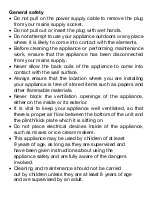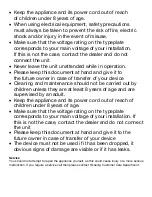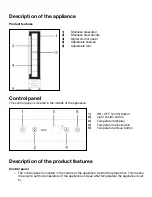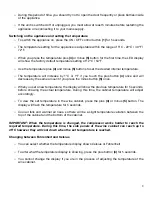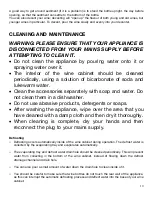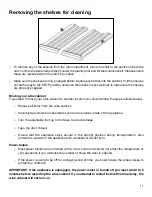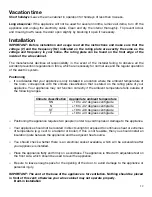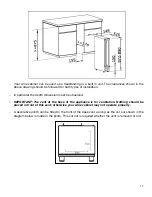
10
A good way to get around sediment (if it is a problem) is to stand the bottle upright, the day before
opening, so that the sediment can settle to the bottom of the bottle.
You can also decant your wine; decanting will “open up” the flavour of both young and old wines, but
younger wines in particular. To decant, pour the wine slowly and evenly into your decanter.
CLEANING AND MAINTENANCE
WARNING: PLEASE ENSURE THAT YOUR APPLIANCE IS
DISCONNECTED FROM YOUR MAINS SUPPLY BEFORE
ATTEMPTING TO CLEAN IT.
•
Do not clean the appliance by pouring water onto it or
spraying water over it.
•
The interior of the wine cabinet should be cleaned
periodically, using a solution of bicarbonate of soda and
lukewarm water.
•
Clean the accessories separately with soap and water. Do
not clean them in a dishwasher.
•
Do not use abrasive products, detergents or soaps.
•
After washing the appliance, wipe over the area that you
have cleaned with a damp cloth and then dry it thoroughly.
•
When cleaning is complete, dry your hands and then
reconnect the plug to your mains supply.
Defrosting
o
Defrosting occurs automatically inside of the wine cabinet during operation. The defrost water is
collected by the evaporating tray and evaporates automatically.
o
The evaporating tray and defrost water drain hole should be cleaned periodically. This will prevent
water from collecting in the bottom of the wine cabinet, instead of flowing down the defrost
drainage channel and drain hole.
o
You can also pour a small amount of water down the drain hole to clean inside of it.
o
You should be careful to make sure that wine bottles do not touch the rear wall of the appliance,
as this can interrupt the automatic defrosting process and deflect water into the base of your wine
cabinet.



